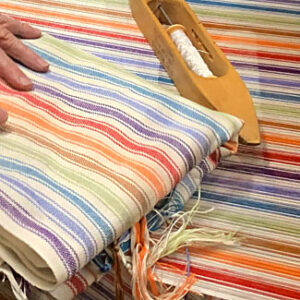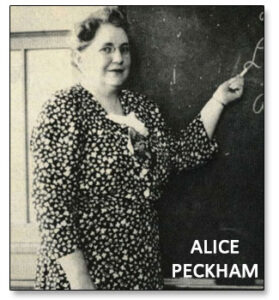FLOOR LOOM DEMONSTRATIONS
On the second floor in Jean’s Sewing Room, I was recently introduced to a 1951 wooden floor loom. To the unfamiliar, (such as myself), it commands attention as the largest display in the room. Each of the 528 parallel warp threads are arranged just so – in an intricate, precise setup. Perhaps a bit intimidating at first site, Brenda Gilmer, the museum’s volunteer weaver, assures me “it’s not complicated”.
ALICE PECKHAM
The museum was fortunate to receive the loom along with a generous supply of weaving yarn as a donation from the Alice Peckham family. Mrs. Peckham was a Home Economics, English and Math teacher at Mapleton High School from 1947 through the 1950s. The loom was actively used by three generations of weavers in her family. It is described as a four-shaft, direct tie-up counterbalance Allen loom, built in Milwaukee, Oregon.
WEAVING AS A THERAPEUTIC TREATMENT
Brenda learned to weave while living in the same Montana town where renowned artist and master weaver Mary M. Atwater once lived. In 1916 Ms. Atwater, an early Occupational Therapist, went to Fort Lewis, Washington and Letterman Hospital in San Francisco to establish weaving programs to help recovering WWI Army servicemen. She claimed weaving was beneficial in “giving one a sense of mastery and creation”.
 THE FINISHING STEP
THE FINISHING STEP
During her demonstration, Brenda will explain when the weaving (“web”) is removed from the loom, it remains ‘unfinished’ and does not yet become cloth as we may know it. As a final step, the web or woven piece must be immersed in water, agitated, then dried during a ‘fulling’ process. The friction and shrinkage allows the threads to thicken, bind together, and become entwined.
Stay tuned for a possible future demonstration day at the museum of several textile crafts including the fulling process.
Story by Deb Lobey, July 2024
Sources:
Mary Meigs Atwater Weavers Guild; Mary Meigs Atwater – The Beginning
https://www.mmawg.org/docs/Atwater/AtwaterBio.pdf
Mary Meigs Atwater Weavers Guild; Mary Meigs Atwater History and Resources
https://www.mmawg.org/Atwater.htm
U.S., School Yearbooks, 1880-2012. School Name: Mapleton High School; Year: 1948
https://www.ancestry.com/discoveryui-content/view/1461445781:1265



